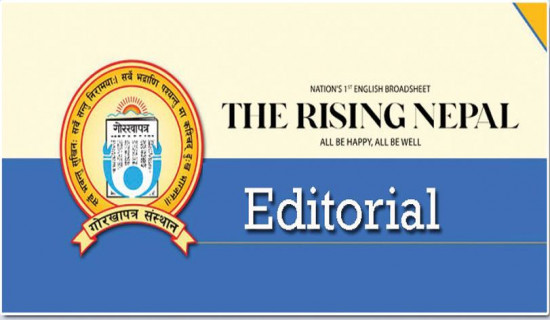- Tuesday, 16 September 2025
Post-disaster Urgency
High-intensity precipitation over a short period of time led to floods and landslides causing massive devastation in Koshi and Bagmati Provinces on Friday and Saturday. It was the heaviest rain the capital valley had witnessed in the last 54 years. Most of country received torrential rains and ensuing floods and landslides, which threw lives of the people out of gear throughout the country. Hit hard by this unprecedented natural disaster, major highways and roads across the country have been partially or completely obstructed from Saturday onwards breaking their connectivity with Kathmandu.
Floods and landslides of unanticipated scale wreaked havoc on private and public infrastructures like houses, schools, bridges, power house dams, telephone towers, roads, etc., all over the country. Media reports say that the main highways are obstructed at 57 different locations. This has brought ground transport mobility to a grinding halt. Many travelers have been stranded mid-way while others lost their lives and were hurt. The number of death toll from the recent floods and landslides reached 170 so far, and 42 others are reported missing.
The BP Highway has suffered the most damage while Tribhuvan Highway has been blocked at Jhyaplekhola in Dhading. Many vehicles were hit by landslips and buried. The cutting off of the transportation link between the capital valley and other places has seriously disrupted the supply of necessities. Under the Araniko Highway, roads at Simle, Dhakalang, Kodari and Dolalghat-Chautara have been closed. The Lipping Bridge in Sindhupalchowk has also been washed away. The Mid-Hill Highway has been obstructed above Bhanda Khola in Okhaldhunga. This shows that the latest monsoon calamity has impacted the nation from east to west.
As major festivals like Dashain, Tihar and Chhath are approaching, this is the time for people from the Kathmandu Valley and other urban centres to travel to their hometowns to celebrate the annual festivals. However, the devastations caused to the main highways have made it challenging for people to return home for family reunion and celebrations. People are scared to travel after the major landslide at Jhayaplekola in Dhading which claimed the lives of 35 commuters. Highways are often considered the economic lifeline for millions of people, so their blockage has hindered economic activities, resulting in huge economic losses. The blocking of the highways is likely to cause the shortage of essential items such as vegetables, fruits, medicines and fuels on the eve of the important festivals.
Likewise, the price of essential items has started to go up in the Kathmandu Valley, making it difficult for the people already hit by calamities to make ends meet. Similarly, people displaced by floods and landslides throughout the country suffer a high risk of infectious disease outbreaks, and scarcity of safe drinking water, food, medicine and other essential items. The affected people also need safe shelter and clothing before their homes becomes livable again. Foreign tourists stranded on the way also need necessary help.
Big losses of lives and property occurred during this disaster despite the early warning of downpours issued by the Department of Hydrology and Meteorology. The incident has taught us some lessons regarding the sound disaster preparedness on the part of the government and social service organisations. Along with the immediate relief plan, the government needs to focus on long-term measures like making river embankments and relocate the people residing along the river banks prone to floods. It is imperative to provide relief to the disaster victims and rehabilitate those affected by the unanticipated calamities.















